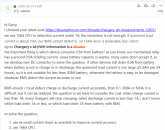Whoa, everyone to a neutral corner and take a breather!
I agree that the Chargery has deficiencies well noted all over the forum.
I am happy with my 16t just for cell level monitoring and balancing during charge only. I have never top or bottom balanced my 16 cell 60Ah fortune battery and the Chargery has kept it happy from day 1.
I don’t use LVD or HVD in my application and I understand my use case is unique perhaps. I did spend $20 for a Drok monitor for SOC and haven’t even bothered to hook it up. The inability of the Chargery to read amps in less than whole numbers does drive me crazy so I will add the Drok at some point.
Believe me I have gotten much less for much more money on many solar items purchased and considered the cost tuition. The Chargery has been an education as well but I am satisfied I got plenty of functionality for the price paid IMHO.
I recognize that people have a legitimate b!tch about the SOC issue so I am not arguing that at all. I just wanted to add one voice of a satisfied customer for MY application.
I agree that the Chargery has deficiencies well noted all over the forum.
I am happy with my 16t just for cell level monitoring and balancing during charge only. I have never top or bottom balanced my 16 cell 60Ah fortune battery and the Chargery has kept it happy from day 1.
I don’t use LVD or HVD in my application and I understand my use case is unique perhaps. I did spend $20 for a Drok monitor for SOC and haven’t even bothered to hook it up. The inability of the Chargery to read amps in less than whole numbers does drive me crazy so I will add the Drok at some point.
Believe me I have gotten much less for much more money on many solar items purchased and considered the cost tuition. The Chargery has been an education as well but I am satisfied I got plenty of functionality for the price paid IMHO.
I recognize that people have a legitimate b!tch about the SOC issue so I am not arguing that at all. I just wanted to add one voice of a satisfied customer for MY application.





